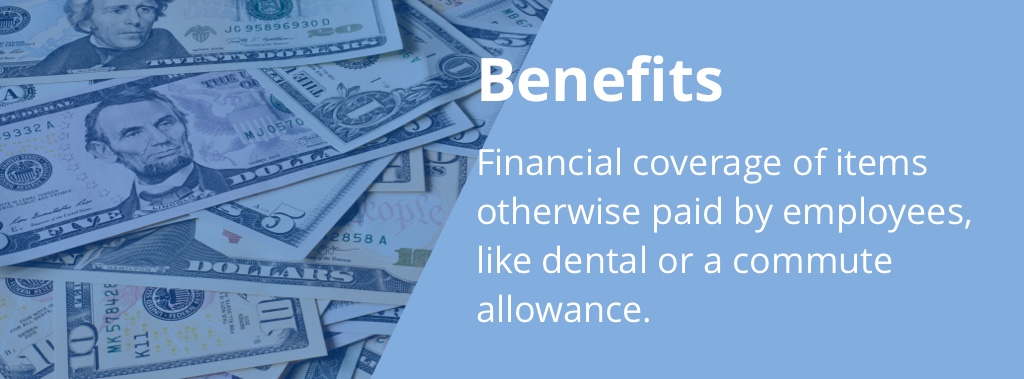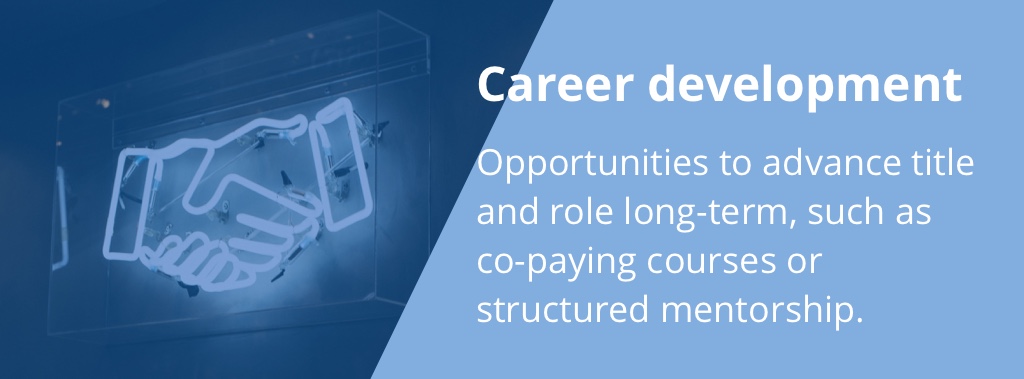6,850 studies about employee happiness and productivity have been published in the first quarter of 2021 alone, and they all agree on two things:
Unfortunately, giving your workers a raise is — by definition — an expensive way to keep them happy.
Thankfully, there are plenty of ways to improve morale without giving out endless raises. In fact, all of the companies featured below outperform higher-paying companies by 11% or more in terms of output relative to employee count for their industry, in spite of offering below-market salaries.
In this post, I’ll show you exactly how to make your employees happier without increasing their pay. Here’s what to expect:
- 5 common formulas for employee retention that can benefit your company today.
- 21 free or low-cost perks (I guarantee you haven’t heard of half of them).
- 3 examples of companies using unique benefits to keep employees happy and productive.
- A summary of cutting-edge industry research into the latest trends in employee retention and happiness/productivity.
At the end, you’ll understand exactly how to deploy non-financial benefits that turn job-hopping bench warmers into loyal team leaders.
Be sure to check out the examples section, where I’ll demonstrate how Silicon Valley tech companies have turned one weird low-cost perk into a $16,000 annual net productivity gain per employee.
The Retention Formula: three types of company

Keeping employees happy and engaged isn’t a question of throwing stuff at the wall to see what sticks.
You have to tailor your strategy to the type of company you are, to avoid wasting money on perks that don’t move the needle on employee output.
At a high level, there are five types of retention tools:
- Benefits: financial coverage of items otherwise paid by employees, like dental or a commute allowance.
- Career development: opportunities to advance title and role long-term, such as co-paying courses or structured mentorship.
- Perks: non-essential “nice to haves,” like free coffee or massage visits.
- Culture: community benefits, like happy hours or volunteer days.
- Lifestyle lures: lifestyle allowances, like remote work days or flex hours.
No company should deploy all types of benefits — most should focus on just one or two of these areas.
Unless you’re Google and Facebook, there’s a diminishing return to delivering non-financial compensation.
Instead, most companies get results with non-financial activities, such as creating an enjoyable culture; giving employees freedom from monitoring or oversight at work; internal award programs; or granting flexible hours.
Which area you focus on depends on the type of company you’re working with. Broadly speaking, companies fall into these five categories (in terms of perks and benefits):

The scrappy startup
You can’t compete on salary, and the lifestyle is obviously poor due to the 24/7 workload; aside from equity, you have to rely on perks and culture to keep employees engaged.
How to keep employees happy without raises at a startup:
- Fun perks
- Fast-growth culture

Small companies
Small companies often struggle to meet or exceed market rates salaries and keep up with employee expectation for annual raises. They can win by focusing on Lifestyle (where they’re more flexible than startups) and culture (where they can be more authentic than corporates). Small companies can also consider lower-cost cities for talent, which often have lower employee expectations compared with hot job markets like Los Angeles or the Bay Area.
How to keep employees happy without raises at a small company:
- Lifestyle benefits
- Strong company culture

The mid-market contender
The danger for this employer is FAANG competitors, who simply out-spend on salary steal the best talent. Mid-market has to rely on culture and career development to retain and please talent. They also have to set clear employee expectations around performance, promotions, and company policy so that employees don't get frustrated and jump to a bigger company with more established expectations.
Something as small as an average annual review rating for an employee expecting more than "meets expectations" can result in defection for companies in this size range.
How to keep employees happy without raises at a mid-market corporation:
- Company Culture (avoid “corporate creep”)
- Career development opportunities

The Nanoglobal (mid-size distributed company)
Nanoglobals often struggle with culture due to the remote work lifestyle, which is a blessing and curse. Nanoglobals need to emphasize culture and career development (usually 1:1 with a mentor) to avoid workers feeling lonely or “stuck” after multiple years.
How to keep employees happy without raises at a nanoglobal:
- Remote-friendly culture
- Career development opportunities

The innovating enterprise
The large enterprise has no trouble meeting market rate salaries, but likely struggles with culture due to size. They have to lean on perks and benefits to keep employees happy.
How to keep employees happy without raises at a startup:
- High-quality perks
- Comprehensive benefits
17 ways to keep employees happy without raises
Now that you know where to focus your effort, here are some ideas of specific perks, benefits, and cultural events to get you started.
I’ve broken things down by category to make it easier to skim and find the strategies that match your business:

Benefits
A 2016 American workforce report revealed that 60% of employees would accept a job offer with a lower salary but better employee health benefits. On top of that, 16% of those respondents said that they had resigned from a job or refused a job offer in the previous 12 months due to a lack of health benefits.
Beyond the obvious like healthcare and 401k match, here are some benefits companies can use to incentivize lower-paid employees:
Commute credit
Commute credits can be as simple as giving employees a small cash benefit for gas, or as complex as taking advantages of state laws in locations like California that allow carpooling and transit to be tax-advantaged for both the employer and the employees.
Check out RideShare.org for more information on how to take advantage of this and get paid to give your employees a solid benefit. As a plus, rideshare employees are guaranteed to arrive on time and tend to work longer hours since they’re tied to a co-worker’s driving schedule.
Childcare services
Childcare might sound expensive, but if you have 50+ employees and only a handful of them have children between 1–4, it can be very cost-effective to bring on a day care benefit, or to compensate for day care services.
Maternity/Paternity packages
Similar to childcare services and day care, maternity/paternity is not as expensive to offer as you might think. Offering a generous package with leave can be a big “plus” for your company when employees are evaluating their options, and the vast majority of employees never use the benefit; or only use part of it, should they have a child.
Home internet compensation
This is one of my favorites, particularly for nanoglobals and remote team members. I started doing this because of ongoing issues with virtual assistants and digital nomads offshore having bad internet; I simply paid for them to get the best internet plan available at their location, and the problem was solved (this more than paid for itself in productivity gains and loyalty in my case).

Career development
Many employees are motivated by the prospect of being promoted within the company they currently work at. Because of this, the promise of career progression can be a great way to keep employees happy without a raise.
According to a study done by the American Journal of Business and Management, career development programs and commitment to employees from management have a positive effect on workers’ satisfaction. This means that they’ll be more likely to stay with the business if it offers them the prospect of internal promotion.
1:1 Mentorship program
Structured mentorship is more than just management theory; it can be a powerful tool for keeping employees happy because it gives you and your management team a chance to “frame the story” about the employee’s career. If they’re not paid market rate, but they have big career ambitions, this is a great way to provide them a tangible value they’ll want to stick around for.
People also feel more accountable to individuals than brands, so mentorship programs are helpful for larger corporations in particular, where burnout and alienation are common.
Job title transitions
Employees who have one job title and covet another are a gold mind for the right company, because they are highly incentivized to perform and will be extremely grateful if you personally help them move to a more desired job title. This is especially a good tactic for employees who want to switch disciplines, for example a designer who wants to get into product management.
Continued education stipend
High-quality online coursework for job tracks like design, product, and engineering are surprisingly affordable. Many of the course platforms like Coursera and Udemy offer business discounts so you can give your employees course access relevant to their field for pennies on the dollar.

Perks
Perks are offerings for employees on top of existing salary, bonus, and benefits. While often affordable and seemingly trivial (Kombucha keg anyone?), a whopping 64% of millennials believe that perks are extremely important to company loyalty and a positive company culture.
Employee deal programs
There are dozens of programs like Corporate Offers, Lifecare, and Perkspot that will offer deals and discounts on home goods and services for employees and teams. The best part is, these programs are often free; or some will even pay for the chance to market promotions to your employees!
Snacks and Lunches
Snacks and lunches are a great perk, and not just because they save time for employees and incentivize them to spend more time at their desk. Companies like Google are notorious for using food perks to get teams cross-pollinating, and positioning food and snacks to get employees on their feet regularly and to help facilitate chance encounters that can lead to new product ideas and cross-department collaborations.
Coffee & Tea Table
If spending on an occasional team lunch or snack cart is too much for your company, the cheapest food perk possible is coffee and tea. A caffeinated workforce is a happy workforce, and both coffee and tea cost next to nothing in bulk.
Pet insurance
This odd perk has become oddly popular with corporate and tech companies, since it sounds “warm and fluffy” and thoughtful for employees who adore their pets. The benefit is that it’s insanely cheap; think $4/employee per month.
Meditation app subscriptions
Similar to pet insurance, this is a perk that’s guaranteed to make it seem like your company really cares, without breaking the banks. Meditation is clinically proven to reduce stress and boost productivity, and has become quite popular thanks to trendy apps like Headspace that make it easy and intuitive to practices daily meditation and breathing.

Culture
Company culture is particularly important for industries with high competition for talent, like tech. Even if the pay isn’t top-shelf, a high-end company culture can keep employees happy and engaged.
Recognition and award programs
Financial services company Deloitte recognizes its employees’ good work with a monthly ‘Shining Star’ award that workers can win individually or as a team. The reward, a $50 voucher, is accompanied by team snacks and drinks. This brings staff together and makes them feel appreciated.
Community Events & Happy Hours
Community events and industry happy hours are massively under-utilized as a way of making employees feel like their workplace is fun and relevant. As an added benefit, there are ways to run them without paying for it, should you have a decent office space for holding a casual event.
Organizations like BuiltIn specialize in running recruiting and networking events, and are always looking for companies willing to host an event.
Volunteer event days
Volunteering days can be highly effective at building team bonds and giving employees a sense of purpose; particularly if your company has a mission that struggles to connect with younger employees, who often expect to having a sense of meaning in their work’s impact.
As such, Volunteer days are common among mid-level tech companies, and many companies like Centerfield Media in Los Angeles make volunteerism and giving a core part of their brand identity for engaging with employees.
Inter-department mixers
If running external or semi-public events is too taxing on company resources, or your office space isn’t glamorous enough to host third-party events, inter-departmental mixers are a solid backup plan.
Companies like Huge in NYC host monthly “talk series” where employees present to the company about a topic they’re passionate about, which creates a chance for teams that normally don’t connect to find common ground and get to know each other.
Mixers and internal event series also give employees a chance to share “who they are” with each other, which is helpful in larger corporations and agencies where HR often struggles to keep employees from feeling alienated.

Lifestyle
Finally, companies that are flexible about how, where, and when work is done have a secret super power: lifestyle benefits.
Companies like Gumroad and Basecamp are notorious for offering unheard of benefits like full-time remote work, fully flexible hours, and even long-term sabbaticals for their employees.
The best part about lifestyle benefits is, when structured right, they actually save the employer significant money; it turns out that employees will take a big pay cut with a smile if they get lifestyle improvements like working from home in return.
Flex Hours
The simplest lifestyle benefit for all types of companies is “flex hours,” meaning that employees who otherwise are stuck on a rigid 9–5 schedule get a certain amount of flexibility built into their week by default. Just giving employees the choice of whether they work from 9–5 or 10–6 works wonders for employee happiness, because it gives them a sense of control over their time.
This isn’t as fluffy as it seems; gaining a sense of control over their time and schedule is clinically proven to increase happiness.
Work From Home Days
Work from home days are likely to see a big boost in popularity post-Covid, as many mid-size companies discovered that remote workers are actually happier and more productive in certain roles, without the need for increased pay.
Offering just one or two “work from home” days each month can be a huge help in keeping an employee happy if they aren’t eligible for a raise or pay increase after a certain anniversary of work for your company.
Sabbaticals
Sabbaticals are a more risky and uncommon non-financial benefit, but they’ve been shown to be effective by small startups like Gumroad as well as large corporations like Suncorp Bank.
With a CEO approval rating of 89%, Suncorp enables employees to access flexible working arrangements such as “career breaks” where an employee can elect to take an extended time away at reduced or no pay, and return to their role without punishment.
This makes a ton of sense for larger companies where employee churn is a cost center, and giving an employee a few months with the result of retaining them an additional 4–10 years is a better outcome than having them quit because they need two months to care for a dying parent or other family emergency.
Async communication mandates
Mid-size tech companies like Wordpress are famous for their async communication policies, meaning that meetings and same-time chats are kept to an absolute minimum in favor of extended focused work followed by detailed write-ups and commentary in email or thread form.
Aside from saving money on endless team meetings, async communication boosts employee happiness by letting specialists spend most of their day doing the job they like, rather than sitting in a room talking about it. However, this obviously only works well for specialized roles and businesses like software development.
Pick-your-own-project policy
Finally, letting employees choose the specific work they do and what project they tackle is a growing trend in startups. VC thought leaders like @naval have popularized the idea that employees should only work on the single thing that they have a passion for, and large startups like Gumroad have gotten a lot of press in 2021 for maintaining employee-driven product roadmaps.
I’ll discuss Gumroad in more detail in the examples below; it’s an interesting case study for keeping employees happy with less money, less upside, and at less cost to the business by avoiding benefits entirely.
3 Examples of companies with happy employees at or below market pay
Red Ventures
Red Ventures is a good example of a mid-size corporation that effectively uses company events, culture, and flexible hours to drive high employee happiness at market or below-market rates.
A review of their Glassdoor shows an impressive 88% approval rating, and while employees frequently point out the lower pay grade relative to the market, they also show gratitude for copious career development opportunities and a flexible, casual company culture.
Gumroad
Gumroad founder Sahil Lavingia’s viral article No Meetings, No Deadlines, No Full-Time Employees is a great example of how to reduce benefits, reduce pay, and reduce security — but more than make up for it in employee’s eyes by turning up the volume on lifestyle benefits to 110.
Allowing employees to choose their hours, choose their projects, and avoid meeting entirely allows them to retain high-quality engineers at average or below-average pricing, while the employees are perfectly happy with the tradeoff in terms of lifestyle and ownership of their work.
STATS
STATS is a great example of a company that promotes its staff from within is sporting data company STATS. STATS fosters a supportive, encouraging culture, and because of this, its employees know it has their back. Employees aren’t micromanaged and are allowed to take full ownership of their projects, meaning they flourish and succeed and demonstrate their value to the company.
Against the grain: the latest research into employee happiness and productivity
At the end of the day, employees aren’t happy because they’re paid the most. They’re happy because their needs are met and they have some level of mastery and autonomy in their work.
In the structured workplace, this means giving employees the chance to be leaders at all levels of the business.
According to the Journal of Leadership and Organizational Studies, successful leadership involves reinforcing and motivating employees to encourage improved performance. This can be done via both financial and non-financial rewards. Participants in this study stated that they highly valued personal recognition for doing their job well. They believed that leaders in all industries should give employees more attention for a job well done if they wish to increase worker satisfaction and happiness.
Employee recognition might be as simple as a quick ‘thank you, good job’ and an acknowledgment; however, there are also other ways you can show your employees you appreciate their work. A voucher for lunch or an experience is always a great way to show appreciation, and employees will stick around for both the recognition and the reward.
Mythbuster: the way to an employee’s heart is through their pocket
As stated above, higher pay is correlated with higher morale.
However, the effectiveness of increased pay decreases dramatically once the cost of living is exceeded by 60% or so.
In fact, the same studies linking pay grade to happiness also show diminishing returns for pay increases after $75,000 per year (or $90,000 per year when accounting for inflation in 2021).
The specific cutoff will obviously vary by location and job title, but the point remains: happy employees require benefits and perks outside their pay.
The main thing to remember is that your employees want to be able to enjoy their jobs. Implementing flexible working strategies and some sort of benefits scheme, as well as recognizing and rewarding good work and offering clear career pathways and progression, are all great ways to keep employees happy without a raise.
Frequently Asked Questions
How important is salary for keeping employees happy?
Formal research in employee productivity suggests that employee happiness decreases when paid below-market rates, and that happy employees are 12% more productive or more. Perks and benefits are the key to improving employee morale after the base salary meets market rates.
How much salary will make employees happy?
Princeton's 2010 study showing that $75,000 salary is the standard for happiness among employees is widely cited, and the basis of minimum-pay company experiments like Gravity Payments. However, the amount needed to satisfy employees ranges from $35,000 for low-stress work in low-cost cities to $275k or more for high-stress work in high-cost cities.
What is considered a good raise in 2021?
Any raise above 10% is considered a good raise, considering inflation in 2021. Raises below 3% are effectively just tracking inflation, while 4–7% is a good gesture but still not a big difference unless you stack the same rate repeatedly for many years.
 Patrick Ward
Patrick Ward 
 Best Time Tracking Browser Extensions for Remote Teams
Best Time Tracking Browser Extensions for Remote Teams